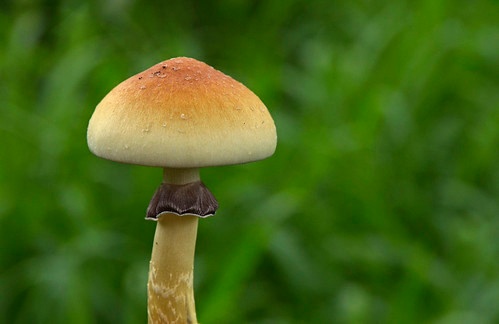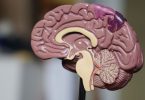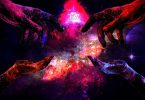Akin to Cannabis sativa, magic mushrooms provide an array of interesting phytochemicals that are naturally engaged in a dance of chemical reactions. We’ll start with psilocybin, seemingly the most common molecule associated with Psilocybe cubensis. Although psilocybin isn’t the main hallucinogen in psychedelic mushrooms, it’s thought to provide a chemical weapon against insects that want to eat it. [1] The mushrooms facilitate the decay of wood with other creatures such as termites that compete for the same food supply, and the psilocybin provides protection as it’s said to modulate the behavior of the competition. I wonder what the termites see?
An enzyme called phosphatase catalyzes the transformation of psilocybin to psilocin which provides the characteristic hallucinogenic effect when the mushrooms are consumed. This reaction cleaves off a phosphate (PO42-) group in a process termed dephosphorylation. Psilocin (the molecule responsible for the standard hallucinogenic experience), in turn, can undergo oxidative oligomerization, a fancy term for creating polymers out of monomers (single molecular units). Oddly, some of these structures produce a blue color.
Some mushrooms will develop an azure hue when injured such as from being cut by a blade. Some may turn blue with age. While the chemical process for the bluing is well-known for some mushrooms, the scheme of how this happens has proved elusive for Psilocybe species despite several decades of investigation. Somehow, that doesn’t seem at all surprising given the majestic mysteriousness of the plant.
Research has shown that the blue color can be provoked via a chemical or enzymatic oxidation of psilocin. [2] Some researchers have speculated that the chromophore (color-causing compound) could be a quinone, a finding that has been supported chemically using reducing agents that decolorize the blue. The blue hue can be resurrected using oxidizing agents. And in the presence of phosphatase, psilocybin can also unveil cerulean shades.
A 2019 paper sought to prove once and for all what causes magic mushrooms to turn blue. [3] Dephosphorylation. Oxidation. Oligomerization. These three words adequately described the chemical verses, but could these researchers prove it?
Using purified phosphatase and a laccase (enzyme that oxidizes phenolic compounds) extracted from P. cubensis, the researchers choreographed the purposeful transformation of psilocybin to psilocin, and the subsequent oxidation and oligomerization. They analyzed the structures of the oligomers using matrix-assisted laser desorption ionization mass spectrometry (MALDI-MS), infrared spectroscopy (IR), and nuclear magnetic resonance spectroscopy (NMR).
Some key findings were that the laccase only worked on psilocin; the structural analysis indicated quinonic products as previously suggested in the literature. [4] The instrumental methods enabled the researchers to unearth key secrets in the formation of the blue hue in wounded mushrooms. Mass spec provided evidence for the oxidative coupling; IR demonstrated carbon-carbon single bonds and carbonyl (C=O) bonds; and NMR helped identify specifically which carbon atom provided the coupling position, all of which pointed to a quinonic molecule.
This work demonstrates the chemical weapons of our natural world and provides an analogous strategy to a plants’ release of terpenes in response to some form of attack. It also provides a wonderful example of how analytics help conquer natural mysteries sometimes bond by bond.
References
- Reynolds HT, Vijayakumar V, Gluck-Thaler E, Korotkin HB, Matheny PB, Slot JC. Horizontal gene cluster transfer increased hallucinogenic mushroom diversity. Evol Lett. 2018;2(2):88-101. [journal impact factor = 4.6; times cited = 32 (Semantic Scholar)]
- Levine WG. Formation of blue oxidation product from psilocybin. Nature. 1967;215(5107):1292-1293. [journal impact factor = 45.819; times cited = 13 (Semantic Scholar)]
- Lenz C, Wick J, Braga D, et al. Injury-triggered blueing reactions of psilocybe “magic” mushrooms. Angew Chem Int Ed Engl. 2020;59(4):1450-1454. [journal impact factor = 12.959; times cited = 3 (Semantic Scholar)]
- Laatsch H. Yearbook of the European College for the Study of Consciousness 1997. 1998:241-256.
Image Credit: “Psilocybe cubensis” by Carlos De Soto Molinari is licensed under CC BY-NC-ND 2.0








